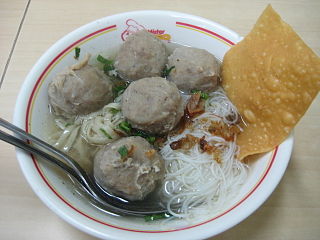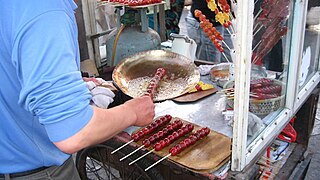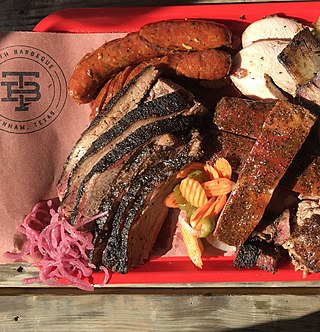
A sausage is a type of meat product usually made from ground meat—often pork, beef, or poultry—along with salt, spices and other flavourings. Other ingredients, such as grains or breadcrumbs may be included as fillers or extenders.

Salami is a cured sausage consisting of fermented and air-dried meat, typically pork. Historically, salami was popular among Southern, Eastern, and Central European peasants because it can be stored at room temperature for up to 45 days once cut, supplementing a potentially meager or inconsistent supply of fresh meat. Countries and regions across Europe make their own traditional varieties of salami.

A hot dog is a food consisting of a grilled or steamed sausage served in the slit of a partially sliced bun. The term hot dog can refer to the sausage itself. The sausage used is a wiener or a frankfurter. The names of these sausages commonly refer to their assembled dish. Some consider a hot dog to technically be a sandwich. Hot dog preparation and condiments vary worldwide. Typical condiments include mustard, ketchup, relish, onions in tomato sauce, and cheese sauce. Common garnishes include sauerkraut, diced onions, jalapeños, chili, grated cheese, coleslaw, bacon, and olives. Hot dog variants include the corn dog and pigs in a blanket. The hot dog's cultural traditions include the Nathan's Hot Dog Eating Contest and the Oscar Mayer Wienermobile.

Chorizo is a type of pork cured meat originating from the Iberian Peninsula.

Boerewors, is a type of sausage which originated in South Africa. It is an important part of South African, Zimbabwean, Botswana and Namibian cuisine and is popular across Southern Africa. The name is derived from the Afrikaans words boer ("farmer") and wors ("sausage"). According to South African government regulation, boerewors must contain at least 90 percent meat, and always contain beef, as well as lamb, pork, or a mixture of lamb and pork. The other 10% is made up of spices and other ingredients. Not more than 30% of the meat content may be fat. Boerewors may not contain offal or any "mechanically recovered" meat pulp.

A chili dog is a hot dog served in a bun and topped with a meat sauce, such as chili con carne. Additional toppings may include cheese, onions, and mustard. The style has multiple regional variations in the United States, many calling for specific and unique sauce ingredients, types of hot dogs, or types of buns and referred to regionally under region-specific names.

A Vienna sausage is a thin parboiled sausage traditionally made of pork and beef in a casing of sheep's intestine, then given a low temperature smoking. The word Wiener is German for Viennese. In Austria, the term "Wiener" is uncommon for this food item, which instead is usually called Frankfurter Würstl.

A michigan hot dog, michigan red hot, or simply "michigan", is a steamed all-beef hot dog on a steamed bun topped with a meaty sauce, generally referred to as "michigan sauce", and is a specialty in and around Plattsburgh, New York.

Charcuterie is a French term for a branch of cooking devoted to prepared meat products, such as bacon, ham, sausage, terrines, galantines, ballotines, pâtés, and confit, primarily from pork.

Chinese sausage is a generic term referring to the many different types of sausages originating in China. The southern flavor of Chinese sausage is commonly known by its Cantonese name lap cheong.

A hot dog stand is a business that sells hot dogs, usually from an external counter. Hot dog stands can be located on a public thoroughfare, near a sports stadium, in a shopping mall, or at a fair. They are often found on the streets of major American cities. According to one report, some hot dog stands are paying up to $80,000 in rent for prime locations in Manhattan.

Different areas of the world have local variations on the hot dog, in the type of meat used, the condiments added, and its means of preparation.

Bakso or baso is an Indonesian meatball, or a meat paste made from beef surimi. Its texture is similar to the Chinese beef ball, fish ball, or pork ball. The word bakso may refer to a single meatball or the complete dish of meatball soup. Mie bakso refers to bakso served with yellow noodles and rice vermicelli, while bakso kuah refers to bakso soup served without noodles.

Hungarian sausages are sausages found in the cuisine of Hungary. Hungary produces a vast number of sui sausage types. They may be boiled, fresh or dried, and smoked, with different spices and flavors, "hot" or "mild". Many were influenced by their neighbors and brethren.

Korean barbecue is a popular method in Korean cuisine of grilling meat, typically beef, pork or chicken. Such dishes are often prepared on gas or charcoal grills built into the dining table itself. Some Korean restaurants that do not have built-in grills provide customers with portable stoves for diners to use at their tables. Alternatively, a chef uses a centrally displayed grill to prepare dishes that are made to order.

Street foods, ready-to-eat food or drink sold in a street or other public place, such as a market or fair, by a hawker or vendor, often from a portable stall, have variations within both regions and cultures. For example, Dorling Kindersley describes the street food of Vietnam as being "fresh and lighter than many of the cuisines in the area" and "draw[ing] heavily on herbs, chile peppers and lime," while street food of Thailand is "fiery" and "pungent with shrimp paste... and fish sauce" with New York City's signature street food being the hot dog, although the offerings in New York also range from "spicy Middle Eastern falafel or Jamaican jerk chicken to Belgian waffles." In Hawaii, the local street food tradition of "Plate Lunch" was inspired by the bento of the Japanese who had been brought to Hawaii as plantation workers.

Texan cuisine is the food associated with the Southern U.S. state of Texas, including its native Southwestern cuisine influenced Tex-Mex foods. Texas is a large state, and its cuisine has been influenced by a wide range of cultures, including Southern, German, Czech, British, African American, Creole/Cajun, Mexican, New Mexican, Native American, Asian, and Italian.

















